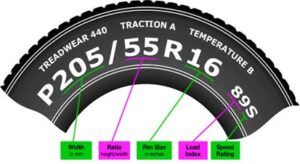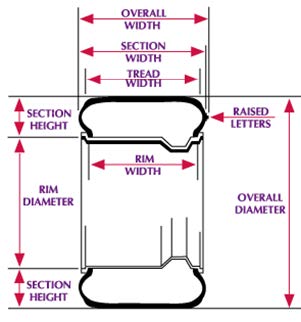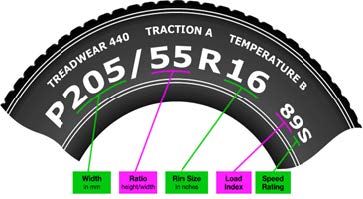37 Tire Sizes and Calculations (by Patrick Jones)
 The tire size branded on the sidewall indicates dimensions, construction, speed and load ratings and durability.
The tire size branded on the sidewall indicates dimensions, construction, speed and load ratings and durability.
Our example will be based on the 205/55R16 size.
The letter P indicates the tire is for a Passenger car and is not related to tire size.
205 identifies the tire’s “Section Width” (cross section) in millimeters.
P205/55R16 89S – The 205 indicates this tire is 205 millimeters across from the widest point of its outer sidewall to the widest point of its inner sidewall when mounted and measured on a specified width wheel. Because many people think of measurements in inches, the 205mm can be converted to inches by dividing the section width in millimeters by 25.4 (the number of millimeters per inch). E.G. = 205 mm ÷ 25.4 = 8.07″
the section width in millimeters by 25.4 (the number of millimeters per inch). E.G. = 205 mm ÷ 25.4 = 8.07″
Sidewall Aspect Ratio Following the three digits identifying the tire’s Section Width in millimeters is a two-digit number that identifies the tire’s profile or aspect ratio. This is the sidewall height as a percentage of width.
P205/55R16 89S The 55 indicates that this tire’s sidewall height (from rim to tread) is 55% of its section width: 205 mm × .55 = 112.75 mm. The measurement is the tire’s section height, and also referred to as the tire’s series, profile or aspect ratio. The higher the number, the taller the sidewall; the lower the number, the lower the sidewall. We know that this tire size’s section width is 205 mm and that its section height is 55% of 205 mm, by converting the 205 mm to inches (205 mm ÷ 25.4 = 8.07″) and multiplying it by 55% (.55) we confirm that this tire size results in a tire section height of 4.43″. If this tire were a P205/70R16 size, our calculation would be: 8.07″ × 0.70, resulting in a section height of 5.69″, approximately a 1.3″ taller sidewall.

The Letter R following the 55 indicates Radial type Construction and is not related to tires size.
Tire and Wheel Diameter:
P225/50R16 89S- The 16 indicates the wheel rim diameter in inches that the tire is designed to be mounted on. So it would be mounted on a 16″ wheel. To determine overall tire diameter, we would add the rim diameter to the previously calculated section height × 2:
16″ + (4.43″ × 2) = 24.86″
or: 16″ + 4.43″ + 4.43″ = 24.86″ overall diameter
To determine the circumference of the tire and wheel assembly we would use the following calculation. Overall diameter × 3.14 (3.14 represents pi, which is a defined formula used to measure circular objects). The circumference of our example assembly would be:
24.86″ × 3.14 = 78.06″ (this is the distance the tire will travel in one revolution.)
Using the learned information and formulas, find two different size tires in the shop and complete the in the activity section chart
(Tire # 1 is shown as our example):
Remember the calculations:
Overall diameter: 16″ + (4.43″ × 2) = 24.86″

